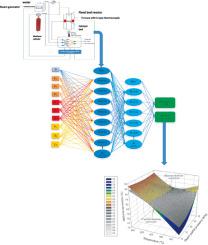Process Safety and Environmental Protection ( IF 6.9 ) Pub Date : 2021-10-19 , DOI: 10.1016/j.psep.2021.10.016 Bamidele Victor Ayodele 1 , May Ali Alsaffar 2 , Siti Indati Mustapa 1 , Adesoji Adesina 3 , Ramesh Kanthasamy 4 , Thongthai Witoon 5 , Sureena Abdullah 6

|
Uncertainty about how process factors affect output might lead to waste of resources in laboratory experiments. To address this constraint, a data-driven method might be used to describe the non-linear connection between process parameters and desired output. A Multi-Layer Perceptron-Artificial Neural Network (MLP-ANN) and non-linear response surface method are used to predict hydrogen generation by catalytic steam methane reforming. The impact of training methods (scaled conjugate and gradient descent), hidden layer variation, artificial neuron variation, and activation functions were studied in 80 MLP-ANN combinations (hyperbolic tangent function and sigmoid function). The performance of MLP-ANN models was affected by the training techniques, activation functions, layer count, and number of artificial neurons. The model with the sigmoid function and 3 input layers, 17 artificial neurons in the first layer, 15 artificial neurons in the second layer, and 2 output nodes had the greatest performance among the 40 configurations of scaled conjugate trained ANNs. It projected an 89.55% maximal hydrogen yield with a coefficient of determination (R2) of 0.997 and reduced errors with Mean absolute percentage error (MAPE) and mean squared error (MSE) of 0.199 and 0.121, respectively. Similarly, the gradient descent ANN model with hyperbolic tangent activation function had the greatest performance among the 40 gradient descent trained-ANN configurations. The 3–15–7–2 gradient descent trained ANN model projected a maximum hydrogen output of 89.73% compared to the experimental results of 89.51%. The MLP-ANN models outperformed nonlinear response surface methods, with R2, MAPE, and MSE of 0.231, 0.191, and 0.988, respectively. The updated Garson algorithm indicated that the input parameters impacted the hydrogen production in the sequence reaction temperature>methane partial pressure>steam partial pressure. The sensitivity analysis might assist identify how resources should be spent.
中文翻译:

催化蒸汽甲烷重整制氢过程强化:多层感知器-人工神经网络和非线性响应面技术的性能分析
关于过程因素如何影响输出的不确定性可能会导致实验室实验中的资源浪费。为了解决这个限制,可以使用数据驱动的方法来描述过程参数和所需输出之间的非线性联系。多层感知器-人工神经网络 (MLP-ANN) 和非线性响应面方法用于预测催化蒸汽甲烷重整产生的氢气。在 80 个 MLP-ANN 组合(双曲正切函数和 sigmoid 函数)中研究了训练方法(缩放共轭和梯度下降)、隐藏层变化、人工神经元变化和激活函数的影响。MLP-ANN 模型的性能受训练技术、激活函数、层数和人工神经元数量的影响。具有 sigmoid 函数和 3 个输入层、第一层有 17 个人工神经元、第二层有 15 个人工神经元和 2 个输出节点的模型在 40 种缩放共轭训练的人工神经网络配置中表现最好。它用决定系数 (R2 ) 的 0.997 和减少的误差,平均绝对百分比误差 (MAPE) 和均方误差 (MSE) 分别为 0.199 和 0.121。同样,具有双曲正切激活函数的梯度下降 ANN 模型在 40 个经过梯度下降训练的 ANN 配置中性能最好。3-15-7-2 梯度下降训练的 ANN 模型预测最大氢气输出为 89.73%,而实验结果为 89.51%。MLP-ANN 模型优于非线性响应面方法,R 2、MAPE 和 MSE 分别为 0.231、0.191 和 0.988。更新后的Garson算法表明,输入参数影响产氢的顺序为反应温度>甲烷分压>蒸汽分压。敏感性分析可能有助于确定应如何使用资源。











































 京公网安备 11010802027423号
京公网安备 11010802027423号